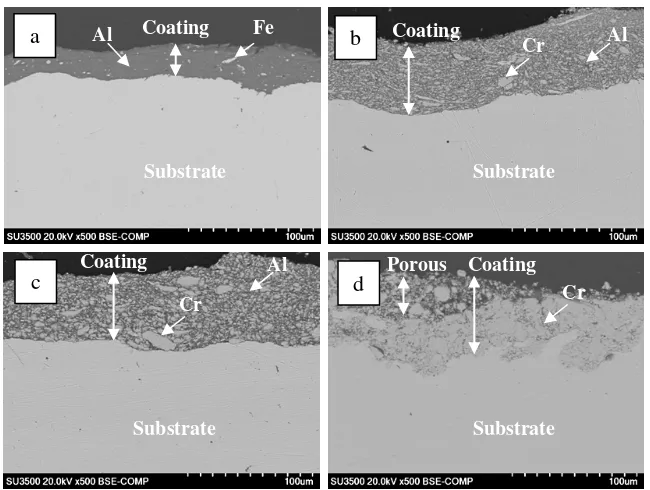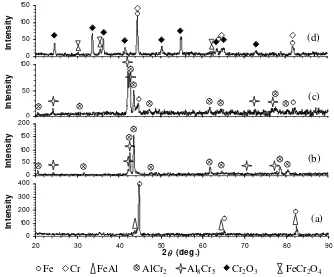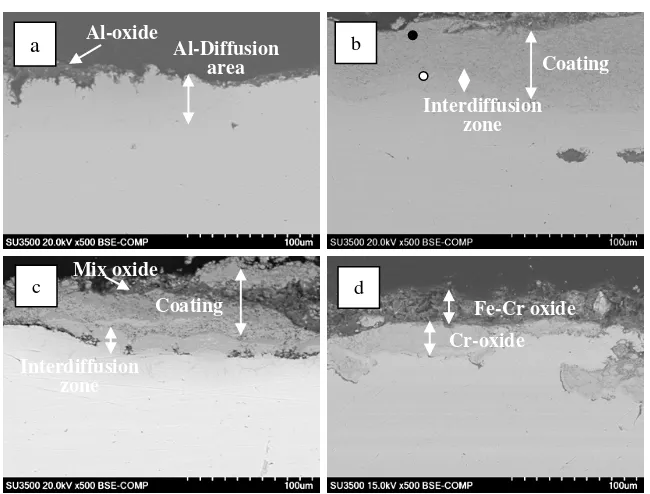Journal of Physics: Conference Series
PAPER • OPEN ACCESS
Cr-Al coatings on low carbon steel prepared by a
mechanical alloying technique
To cite this article: A I J Hia et al 2016 J. Phys.: Conf. Ser. 739 012131
View the article online for updates and enhancements.
Related content
Microstructure transformation of Cr-Al coating on carbon steel prepared by ball milling method as a function of tungsten doping
A S Wismogroho, T Sudiro, A Didik et al.
-Study of the Deburring Process for Low Carbon Steel by Plasma Electrolytic Oxidation
Li Hongtao, Kan Jinfeng, Jiang Bailing et al.
-CMT Welding of Low Carbon Steel Thin Sheets
E M Stanciu, A Pascu and I Gheorghiu
-Recent citations
Microstructure transformation of Cr-Al coating on carbon steel prepared by ball milling method as a function of tungsten doping
A S Wismogroho et al
-Development of MoSi2 coating with Al doping by using high energy milling method
C M S Simanjuntak et al
-High temperature cyclic oxidation resistance of 50Cr-50Al coatings mechanically alloyed on low carbon steel Toto Sudiro et al
Cr-Al coatings on low carbon steel prepared by a mechanical
alloying technique
A I J Hia1, T Sudiro2,*, D Aryanto2 and K Sebayang1
1
Postgraduate Program, Faculty of Mathematic and Natural Science, University of Sumatra Utara, Sumatera Utara, 20155 Indonesia.
2
Research Center for Physics, Indonesian Institute of Sciences, Kawasan Puspiptek Serpong, 15310 Indonesia.
*e-mail: [email protected]
Abstract. Four different compositions of Cr and Al coatings as Cr100, Cr87.5Al12.5, Cr50Al50,
and Al100 have been prepared on the surface of low carbon steel by a mechanical alloying
technique. The composition of each powder was milled for 2 hour in a stainless steel crucible with a ball to powder ratio of 10:1. Hereafter, the Cr-Al powder and substrate were mechanical alloyed in air for 1 hour. Heat treatment of coated sample were carried out at 8000C in a vacuum furnace. In order to characterize the phase composition and microstructure of the coating before and after heat treatment, XRD and SEM-EDX were used. The results show that Cr, Cr-Al or Al coatings were formed on the surface of low carbon steel. After heat treatment, new phases and interdiffusion zone were formed in the coating and at the coating/steel interface, depending on the coating composition.
1.Introduction
Carbon steels have been widely used for wide range applications due to the cost consideration. Mostly, however, it shows low oxidation resistance at high temperature [1]. Accordingly, a protective coating is required to improve their oxidation resistant.
Al2O3 former as FeAl [2], NiAl [3], TiAl [4] and Cr2O3 former as NiCr [5] have been applied as
coating on the samples surface to improve its oxidation resistance. The formation of a protective oxide layer of alumina or chromia on the coating surface can play a role to retard the inward diffusion of oxygen. It is generally agreed that Al and Cr are important elements for improving the high temperature oxidation resistance of alloys and coatings. However, far too little attention has been paid to Cr-Al coating which can act as reservoir for the formation of Al2O3 and/or Cr2O3 on the coating
surface at high temperature.
Several techniques as high velocity oxygen fuel (HVOF) [6], air plasma spraying (APS) [7], physical vapor deposition (PVD) [4] and mechanical alloying (MA) [8-12] have been used to deposit coatings on the surface of materials. It is known that mechanical alloying is a new technique which can be utilized to produce intermetallic coatings on steel [8] and nanostructure coating on various metal surfaces [9]. In this technique, the coatings formation on the sample surface is caused by the ball and powder particles collision on the sample surface. Thus, several factors as coating composition, ball and powder ratio, and rotation speed or oscillation frequency will affect the establishment of coatings on the surface of sample. From the view point of coating development, how to produce uniform coating structure becomes particularly important.
6th Asian Physics Symposium IOP Publishing
Journal of Physics: Conference Series739(2016) 012131 doi:10.1088/1742-6596/739/1/012131
Based on the aforementioned conditions, in this study, Cr-Al coatings with varying composition were prepared by a mechanical alloying technique. Heat treatment was also performed in order to improve or refine the coating structure. Metallographic characterizations of the coating before and after heat treatment were studied by mean of XRD and SEM-EDX.
2.Experimental Procedures
Commercial low carbon steel with an approximate dimension of 10 x 8 x 3 mm was used as substrate in this study. For the coating deposition, the alloy surface was polished down by using various grades of SiC papers for up to #1200. The specimen was then ultrasonically cleaned in an ethanol solution. The nominal composition of powder for coating was presented in Table 1.
Table 1. Nominal composition of Cr-Al coatings (in at%).
Coating Nominal Composition (at%)
The deposition of coating on the surface of low carbon steel was performed in a shaker mill by a mechanical alloying technique. For each composition, the powders were milled for 2 h in the steel crucible by using high speed shaker mill. The steel balls and powder ratio used in this study are 10 to 1. After 2 h milling, the substrate of low carbon steel was charged into the steel crucible containing milled powder and mechanically alloyed for 1 h. The deposition of coating on the surface of low carbon steel occurs due to the collisions between balls and powder on the substrate of low carbon steel. After Cr-Al coatings deposition, the specimens were then heat treated in a vacuum furnace of 5.6 Pa for 2 h at 800oC.
X-ray diffraction (XRD) and scanning electron microscope equipped with energy dispersive X-ray spectrometer (SEM-EDX) were used to characterize the phase composition and microstructure of coating before and after heat treatment, respectively.
3.Results and Discussion
3.1. Phase composition and microstructure of the Cr-Al coatings before heat treatment
X-ray diffraction patterns of Al100, Cr50Al50, Cr87.5Al12.5 and Cr100 coatings before heat treatment are
shown in Figure 1. The XRD analysis shows reflections of Al and Cr in the Al100 and Cr100 coatings as
shown in Figures 1(a) and (d), respectively with some refection peaks of Fe from substrate of low carbon steel. Meanwhile in the Cr50Al50 and Cr87.5Al12.5 coating, both of Cr and Al reflections can be
clearly seen in Figures 1 (b) and (c). The results of XRD characterization reveal that Cr-Al coatings were successfully deposited on the surface of low carbon steel.
The cross-sectional BSE images of Al100, Cr50Al50, Cr87.5Al12.5 and Cr100 coatings before heat
treatment are shown in Figures 2 (a), (b), (c) and (d), respectively.
The thickness of Al coating, as shown in Figure 2 (a) is about 30 µm. EDX characterization confirms small Fe particles in the Al-matrix which probably come from the steel substrate or milling media. During the powder milling or coating deposition, the collisions between steel balls, crucible and sample may lead to steel spallation. From Figure 1 (a), it can also be seen that the Al coating exhibits good adherence to the alloy substrate. In the Cr-Al coatings (Figures 2 (b) and (c)), the coatings are composed of grey particles of Cr and dark area of Al with the coating thickness of about 60-80 µm. The Cr-particles in the Cr50Al50 coating are smaller and more uniformly distributed
compared to in the Cr87.5Al12.5 coating. For Cr100 coating (Figure 2(d)), the thickness and
microstructure of the coating are uneven. A relatively dense structure can be observed on the surface of low carbon steel and porous structure is found near to the surface of the coating. In addition, the
6th Asian Physics Symposium IOP Publishing
Journal of Physics: Conference Series739(2016) 012131 doi:10.1088/1742-6596/739/1/012131
SEM image also shows that the sample surface is rough. This could be related to the fact that Cr hardness (Hv = 1060 MPa) is higher compared to the Fe hardness (Hv = 608 MPa). Accordingly, the deposition of Cr particles on the steel surface strongly affects the morphology of sample surface.
0
Cr87.5Al12.5 and (d) Cr100 coatings before heat treatment.
Figure 2. Cross-sectional BSE images of (a) Al100, (b) Cr50Al50, (c)
Cr87.5Al12.5 and (d) Cr100 coatings before heat treatment.
Substrate Substrate
Coating Porous Coating
0
6th Asian Physics Symposium IOP Publishing
3.2. Phase composition and microstructure of the Cr-Al coatings after heat treatment at 800oC
Figure 3 shows the X-ray diffraction patterns of Al100, Cr50Al50, Cr87.5Al12.5 and Cr100 coatings after
heat treatment at 800oC for 2 h.
XRD patterns, as shown in Figure 3 indicate that the coating structure after heat treatment is depended on the coating composition. In the Al100 coating, FeAl phase is formed after heat treatment
at 800oC for 2 h. In the Cr50Al50 coating, the coating is composed mainly of AlCr2 phase with small
reflections of Al8Cr5 phase. As Cr concentration increases, XRD characterization reveals that Al8Cr5
reflection in the Cr87.5Al12.5 coating is higher and AlCr2 reflection in the Cr87.5Al12.5 coating is lower
than that of in the Cr50Al50 coating. XRD analysis also confirms the Fe reflection from the steel
substrate in the Cr87.5Al12.5 coating. In addition to Cr reflection from the coating and Fe reflection
from steel substrate, in the Cr100 coating, XRD characterization detects the major reflection of Cr2O3
and minor reflection of FeCr2O4. It is obvious that Cr is oxidized preferentially after heat treatment at
800oC for 2 h to form Cr2O3. Meanwhile, the formation of FeCr2O4 may occur according to the
treatment at 800oC for 2 h are shown in Figure 4. It can be seen in Figure 4(a) that the surface of substrate is rough and the Al coating becomes disappear. The EDX elemental maps show the local distribution of Al and O on the surface of steel substrate (Figure 5 (a)). This suggests that the uneven dark area on the steel surface is composed of Al-oxide. In addition, SEM-EDX elemental maps also indicate the presence of Al-rich area close to the steel surface. As the distance from the sample surface into substrate increases, the blue color intensity (Al distribution) tends to decrease and the magenta color intensity (Fe distribution) tends to increase, suggesting that the Al element is diffused inwardly
θ (de
6th Asian Physics Symposium IOP Publishing
Journal of Physics: Conference Series739(2016) 012131 doi:10.1088/1742-6596/739/1/012131
to the steel substrate. Some amount of Al reacts with Fe from the substrate to form FeAl as detected by XRD analysis, as shown in Figure 3(a).
a b
c d
Coating
Interdiffusion zone Al-Diffusion
area
Coating
Figure 4. Cross-sectional BSE images of (a) Al100, (b) Cr50Al50, (c) Cr87.5Al12.5
and (d) Cr100 coatings after heat treatment at 800oC for 2 h.
Fe
Fe
Al
Cr
O
O
Figure 5. Cross-sectional BSE images and corresponding EDX elemental maps of (a) Al100 and (b) Cr100 coatings after heat treatment at 800oC for 2 h.
Meanwhile, a dense and more uniform coating structure are shown in the Cr50Al50 coating (Figure 4
(b)). The coating also exhibits strong adherence to the steel substrate. In this study, EDX point analysis was carried out in the coated sample. The results indicate that the coating composition near the coating surface (marked as black circle in Figure 4(b)) is composed of 51.52%at Al, 46.81%at Cr, 1.67%at Fe and coating/substrate interface (marked as white circle in Figure 4(b)) is composed of 34.44%at Al, 34.2%at Cr, 31.36%at Fe. It shows that from the coating surface to the coating/substrate interface, the Al and Cr concentration decrease and Fe concentration increases. The EDX results also reveal that an interdiffusion zone is formed at the coating/substrate interface. In the Cr87.5Al12.5
coating, localized mix oxides composed of 55.67%at O, 19.99%at Al, 11.99%at Cr and 12.35%at Fe
Al-oxide
Mix oxide
Cr-oxide Fe-Cr oxide
Interdiffusion zone
a
b
6th Asian Physics Symposium IOP Publishing
100 coatings.
ly Cr2O3.
are formed in the coating. The interdiffusion zone is formed at the coating/substrate interface. The intermixing area between coating and oxide can also be seen from the cross-sectional image as shown in Figure 4(c). Meanwhile, in the Cr100 coating (Figure 4(d)), the formation of Cr-oxide can be clearly
seen from the result of EDX elemental maps as shown in Figure 5(b). Mostly Cr coating is oxidized to form Cr2O3 as detected by XRD analysis (see Figure 3 (d)). The formation of Cr-oxide after heat
treatment could be related to the affinity of Cr for oxygen. Chromium has a very high affinity for oxygen, so it can be readily react with oxygen to form chromia [14]. Therefore, even if the partial oxygen pressure is low, the following reaction is likely to take place:
3 2
2 CrO
O
Cr+ → (2)
In addition, The EDX elemental maps also indicate the distribution Fe, Cr and O on the surface of Cr2O3 scale. This suggests that FeCr2O4 seems to be formed in the outer layer. The results as
presented above indicate that the Cr50Al50 coating exhibits good adherence to the steel substrate and
fine coating structure among the Cr100, Cr87.5Al12.5 and Al
4.Summary
Four different compositions of Cr-Al coatings as Cr100, Cr87.5Al12.5, Cr50Al50, and Al100 have been
prepared on low carbon steel by a mechanical alloying technique. The obtained results can be summarized as follow: the heat treatment of Cr-Al coatings on low carbon steel changes the coating structure. In the Al coating, Al is preferentially diffused inwardly to steel substrate to form FeAl and Al-rich area near the sample surface. The Cr Al coating shows a more uniform coating
structure among Al ,
100
50 50
100 Cr87.5Al12.5 and Cr coatings. As Cr concentration increases, complex
structures are formed in the Cr Al coating. For the
100
87.5 12.5 Cr100 coating, after heat treatment at 800 C for
2 h
o
the Cr element is oxidized to form main
Acknowledgments
The authors would like to thanks Research Center for Physics-Indonesian Institute of Sciences for financial support (Grant Number: 934/F/2014) of this project.
References
[1] B Wang, J Wu, Y Zhang, Z Wu, Y Li, and W Xue 2015 Surface & Coatings Technology269 302 [2] S PalDey, and S C Deevi 2003 Materials Science and Engineering A 355 208
[3] S Yang, F Wang, W Wu, and Y Niu 2001 Oxidation of Metals56 33
[4] F A Varlese, M Tului, S Sabbadini, F Pellissero, M Sebastiani, and E Bemporad 2013
Intermetallics37 76
[5] Y Zhang, X Peng, and F Wang 2004 Materials Letters58 1134
[6] N Cinca, S Dosta, and J M Guilemany 2010 Surface & Coatings Technology 205 967 [7] B Song, S Dong, H Liao, and C Coddet 2015 Surface & Coatings Technology 268 24
[8] M Mohammadnezhad, M Shamanian, and M H Enayati 2012 Applied Surface Science263 730
[9] M Mohammadnezhad, M Shamanian, M H Enayati, and M Salehi 2013 Surface & Coatings
Technology217 64
[10]A Canakci, F Erdemir, T Varol, and S Ozkaya 2013 Powder Technology247 24
[11]S Romankov, W Sha, S D Kaloshkin, and K Kaevitser 2006 Surface & Coatings Technology201
3235
[12]S Romankov, S D Kaloshkin, Y Hayasaka, Zh Sagdoldina, S V Komarov, N Hayashi, and E
Kasai 2009 Journal of Alloys and Compounds48 386
[13]X-X Luo, Z-J Yao, P-Z Zhang, Q Miao, W-P Liang, D-B Wei, and Y Chen 2014 Applied Surface Science305 259
[14]J R Davis 1997 Elevated-Temperature Corrosion Properties of Superalloys in ASM Specialty Handbook: Heat-Resistant Materials (ASM International, Materials Park OH), p 146
6th Asian Physics Symposium IOP Publishing
Journal of Physics: Conference Series739(2016) 012131 doi:10.1088/1742-6596/739/1/012131



